Selecting the Right Litter Box for Rabbit: A Comprehensive Guide
Find the perfect litter box for your rabbit with our guide. Tips on size, material, and placement for your bunny's health and happiness.
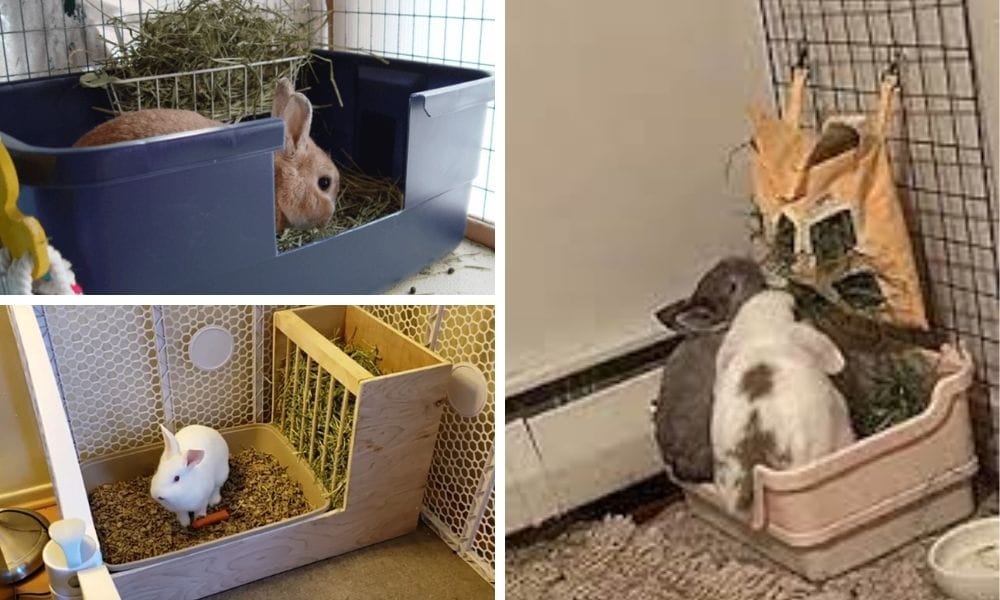
Key Takeaways:
- Choosing the Right Size and Type: Selecting a litter box that fits your rabbit’s size and your cleaning preferences is crucial.
- Material Matters: Opt for materials that are safe and comfortable for your rabbit, such as paper pellets or wood pellets.
- Location and Training: Proper placement and consistent litter box training are key to encouraging your rabbit to use their new bathroom.
- Health Check: If your rabbit stops using the litter box, it is important to check their health, as this behavior could indicate potential health issues.
Rabbits are clean animals by nature, and with the right litter box setup, you can maintain a hygienic environment for both your pet and your home. This guide will walk you through everything you need to know about choosing, setting up, and maintaining the perfect litter box for your bunny.
Introduction to Rabbit Care
Caring for a rabbit involves more than just providing food and water; it requires creating a comfortable and clean environment, which includes selecting the right litter box. A suitable litter box is essential for maintaining your rabbit’s health and hygiene. For a single rabbit, the litter box should be large enough to accommodate their size comfortably. A minimum size of 22L x 17W x 6.5H inches (55L x 43W x 16.5H cm) is recommended to ensure your rabbit has enough space to move around.
Rabbits are sensitive to odors and prefer a clean litter box, making regular cleaning essential. A dirty litter box can lead to health issues and discourage your rabbit from using it. To keep the litter box fresh and inviting, it’s important to establish a regular cleaning schedule. Daily scooping and weekly thorough cleaning with mild, non-toxic cleaners can help maintain a hygienic environment.
In addition to a clean litter box, providing fresh hay daily is crucial. Hay, such as Timothy hay or Orchard hay, not only encourages healthy eating habits but also promotes litter box use. Rabbits often like to munch on hay while they do their business, so placing hay in or near the litter box can make it more appealing.
Rabbits are creatures of habit and thrive on routine. Establishing a consistent cleaning and feeding schedule will help your rabbit feel secure and comfortable in their environment. By paying attention to these details, you can ensure your rabbit’s litter box is a welcoming and functional part of their habitat.
Understanding Rabbit Litter Box Needs
Rabbits require a specific type of care when it comes to their litter needs. Bunny litter boxes are designed to cater to the unique habits of rabbits, such as eating hay in their litter area, emphasizing its use as a toilet or potty training aid for these small pets. Unlike cats, rabbits both poop and pee in their litter box but also often eat hay in the same area. This means the litter box design needs to accommodate space for both a potty area and a feeding area. Providing clean hay in the litter box supports their dietary needs and natural behaviors by allowing them to eat and eliminate simultaneously. Additionally, it is important to dispose of the entire contents of the litter box, including litter, hay, and waste, during the cleaning routine to ensure a hygienic environment.
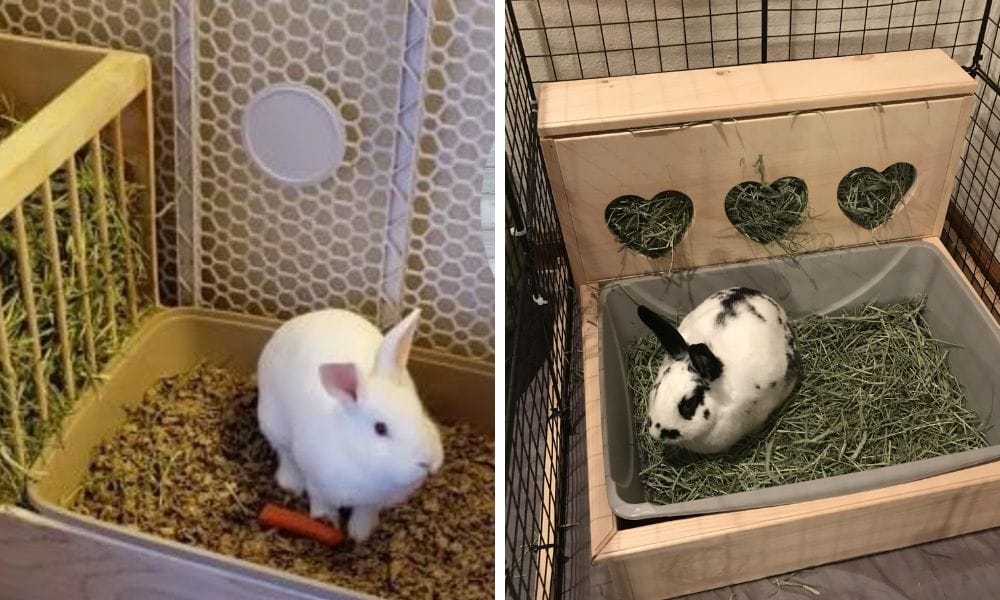
Size and Accessibility
When selecting a litter box for your rabbit, size is an essential factor. Your rabbit should have enough room to comfortably move around inside the box. A general rule is to choose a box that is at least four times the size of your rabbit. This provides ample space for movement and helps prevent any uncomfortable constraints. Opting for a big box is crucial to accommodate activities like digging and napping. Additionally, choosing a bigger box is beneficial for multiple rabbits or larger bunnies, as it helps prevent frequent cleaning and ensures their comfort.
Types of Litter Boxes
There are several types of litter boxes available, from basic models to more advanced designs like the covered litter box. While covered boxes might work for cats, they are not always suitable for rabbits due to their need for a more open space and ventilation to avoid respiratory issues. Unlike cat litter boxes, rabbits often use their litter boxes not just for bathroom purposes but also as a place to eat and nap, which necessitates a different approach in choosing the right type of litter box for them. Suitable storage bins for use as rabbit litter boxes can be found on Amazon, highlighting the versatility and availability of options to meet specific needs for size and depth.
Choosing the Right Material
The material of the litter box is also crucial. Many pet owners prefer plastic boxes as they are easy to clean and light to move. However, ensure the plastic is sturdy enough to withstand chewing and digging. Additionally, using a tray designed for bunnies with a smooth surface can keep their paws clean and dry, effectively funneling away waste while providing a supportive environment.
Litter Options for Comfort and Safety
Choosing the right type of litter can significantly affect your rabbit’s health. Paper pellets, wood pellets, and paper bedding, including paper litter, are among the safest options. These materials are absorbent and less likely to cause respiratory issues compared to cat litter, which should be avoided due to its clumping properties and potential toxicity. Specifically, paper litter is noted for its superior absorbency, excellent odor control, and cost-effectiveness, making it a preferred choice among rabbit owners. Regularly refilling hay feeders and litter boxes is crucial to ensure the well-being and cleanliness of the bunnies. Additionally, it is important to select appropriate bedding and fresh hay for a rabbit's litter box, emphasizing the need for rabbit-safe materials that do not include harmful substances like pine or cedar. By combining the benefits of pine pellets with a top layer of paper bedding, you can create an optimal litter solution that keeps your rabbit’s habitat dry and odor-free.
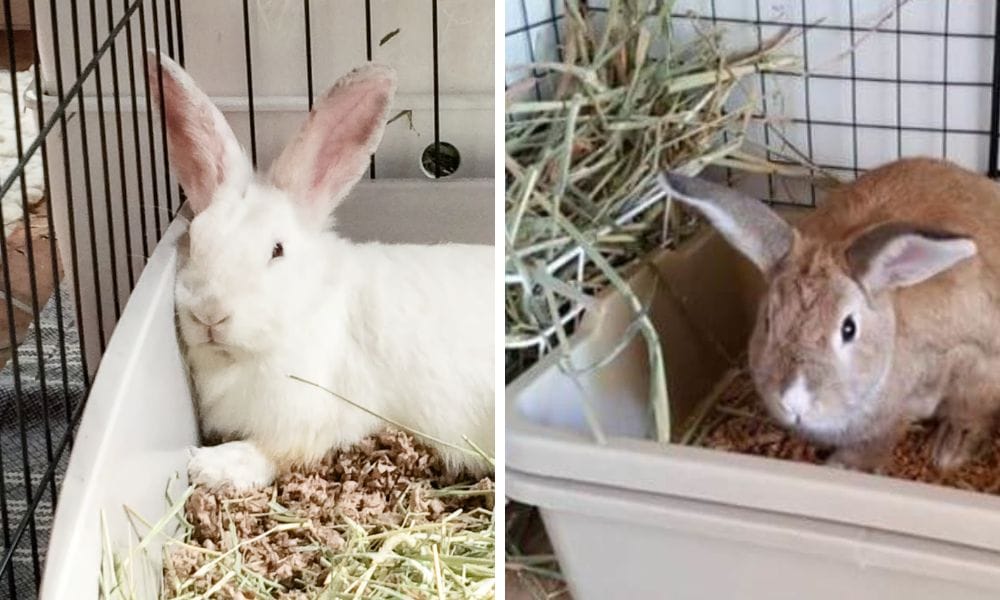
Placement of the Litter Box
The placement of the litter box within your rabbit's enclosure is vital. Rabbits often choose a favorite corner to do their business. Observing your rabbit's behavior can help you decide the best spot to place the litter box to encourage its use.
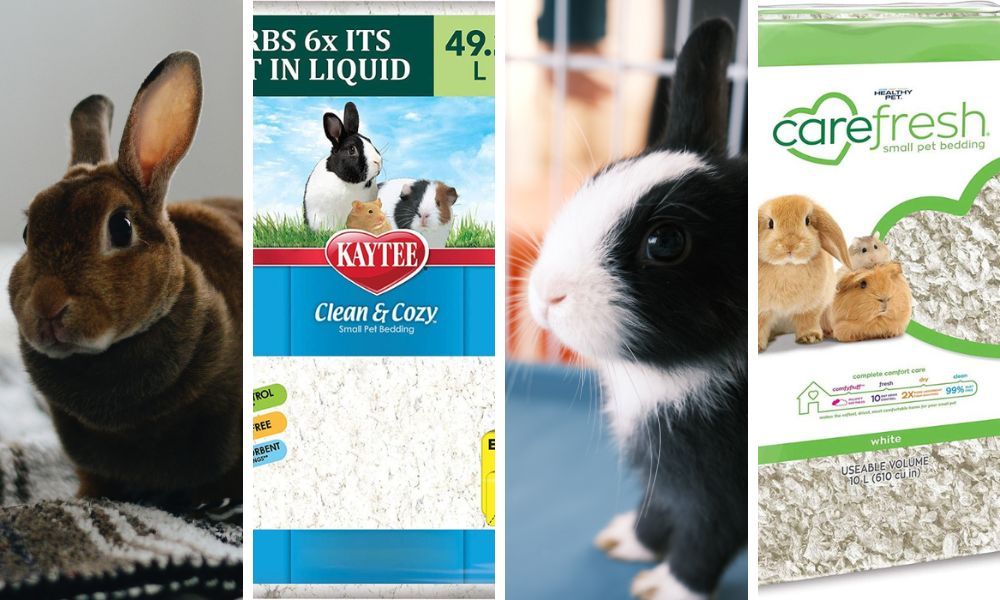
Optimizing Litter Box Location
When setting up a litter box for your rabbit, choosing the right location is crucial. It should be a quiet corner where your bunny feels secure yet is easily accessible. Avoid high-traffic areas where the noise and movement might discourage your pet from using the box. Also, consider the distance from their food and water, as rabbits often like to eat hay and relieve themselves at the same time. Placing the litter box near their hay rack can encourage this natural behavior, making litter box training super easy.
Moreover, ensure the chosen spot is free from drafts and not too close to their sleeping area. Rabbits are clean animals and prefer their toilet area to be separate from where they rest and eat. If you have multiple boxes, space them out within the enclosure to give your rabbit options and prevent any territorial disputes that might arise. Remember, a strategically placed litter box supports good hygiene and helps maintain your rabbit’s health by reducing the risk of respiratory issues from ammonia in urine. Observing the behavior of pet rabbits is essential to choose the best litter box location, as it significantly contributes to their well-being and cleanliness. Additionally, during cleaning, letting vinegar sit in the litter box for a minute can effectively tackle odor and hygiene issues.
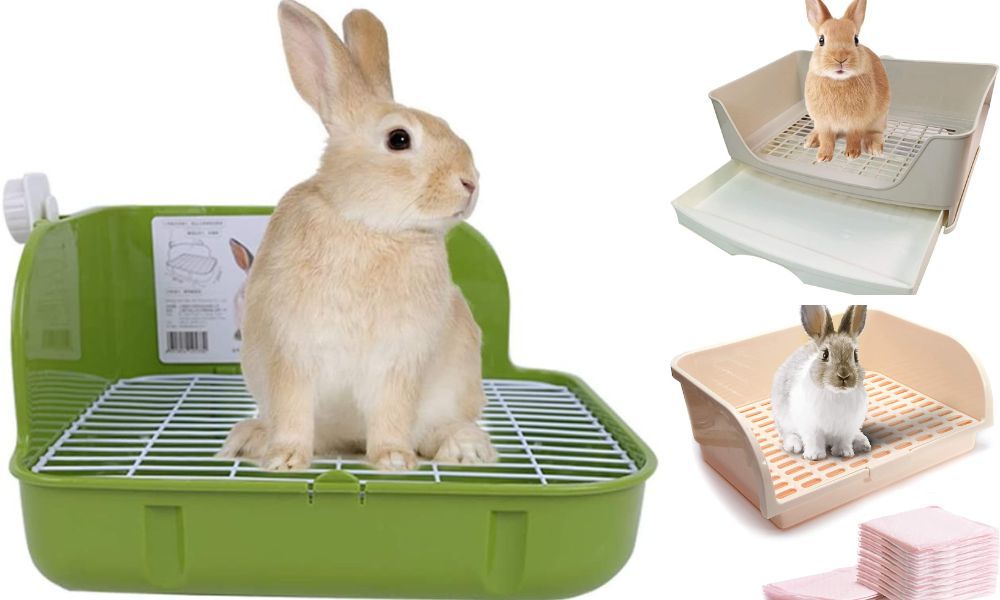
Enhancing Litter Box Usability with Appropriate Accessories
When setting up a litter box for your rabbit, consider incorporating accessories that can enhance the usability and appeal of the litter box. Accessories like a hay feeder attached directly above the litter box can encourage your rabbit to munch on hay while they do their business, which is a natural behavior for rabbits. This not only makes the litter box more inviting but also helps keep the hay clean and dry. Providing a bundle of hay about the size of your rabbit's body when lightly compressed can promote proper usage of the litter box. Additionally, placing a pee pad underneath the litter box can catch any spills, making cleaning up much easier and maintaining a hygienic environment for your bunny.
Another useful accessory is a litter box screen or grid that sits on top of the litter. This can help separate your rabbit from wet litter, reducing the chance of dirty feet and fur, and minimizing the risk of urinary tract infections or pododermatitis. Screens are particularly useful when using paper pellets or wood pellets, as they allow urine to pass through while keeping the solid waste on top for easy removal. Ensuring the litter box is designed for large bunnies, with easy entry and adequate space, is crucial for their comfort and usability. Ensuring these accessories are easy to clean and safe for your rabbit will contribute significantly to their overall well-being and your convenience.
The Importance of Regular Litter Box Updates
Regular updates to your rabbit’s litter box setup can play a crucial role in maintaining their health and happiness. Over time, a litter box can become scratched or worn, which may harbor harmful bacteria or cause discomfort to your pet. Replacing the litter box every few months or as soon as signs of wear appear is crucial for maintaining a sanitary environment. Additionally, experimenting with different types of litter can help you find the most comfortable and safe option for your rabbit, as some may prefer paper pellets for their softness, while others might find wood pellets more to their liking due to their superior odor control.
Moreover, as your rabbit grows and their habits change, their litter box needs might evolve as well. What worked for a young rabbit might not be suitable for an adult. For instance, older rabbits might require a litter box with lower sides for easy access. Keeping an eye on how your rabbit interacts with their litter box and making adjustments as needed will ensure that the litter box remains a welcoming and functional space. Regular updates not only keep the litter box fresh but also show your bunny that they are a valued member of the family, enhancing their quality of life.
The Role of Litter Box Covers
While covered litter boxes are popular among cat owners, they might not be the best choice for rabbits. Bunnies need enough room to move around and stand up fully in their litter box without feeling cramped. A covered litter box might make your rabbit feel trapped and anxious, which can deter them from using it. Instead, opt for an open yet sufficiently deep litter pan that provides privacy and security without the confinement of a lid.
However, if you're concerned about litter being kicked out or odor control, consider a high-sided litter box or a custom solution that includes a partial cover to catch any flying debris while still giving your rabbit easy access and ample air circulation. Always observe your rabbit's behavior with any new litter box setup to ensure they are comfortable and stress-free. This attention to detail ensures the litter box is inviting and easy to clean, which is essential for maintaining a healthy environment for your pet.
Litter Box Training Basics
Litter box training a rabbit is similar to training a cat, with patience and consistency being key. To effectively litter train your rabbit, start by placing multiple litter boxes in their enclosure, as rabbits often choose different spots to relieve themselves. Incorporate hay inside the boxes to encourage use, since rabbits tend to eat while they eliminate. Gradually expand your rabbit’s space as they show consistent use of the boxes, reinforcing good habits. It’s crucial to approach litter training with a gentle and non-punitive method, ensuring your rabbit feels safe and stress-free during the process. The benefits of litter training extend beyond simple cleanup; it allows for easier monitoring of your rabbit’s health through their waste and reduces territorial marking behaviors, especially important in unspayed or unneutered rabbits. Speaking of which, spaying or neutering your rabbit can significantly decrease territorial marking and improve litter habits. Place your rabbit in the litter box after meals and naps, as these are times they are most likely to go. Rewarding them with treats can also help establish a positive association with the litter box. Additionally, it is important to recommend specific products and sizes for rabbit litter boxes to ensure a comfortable and functional setup.
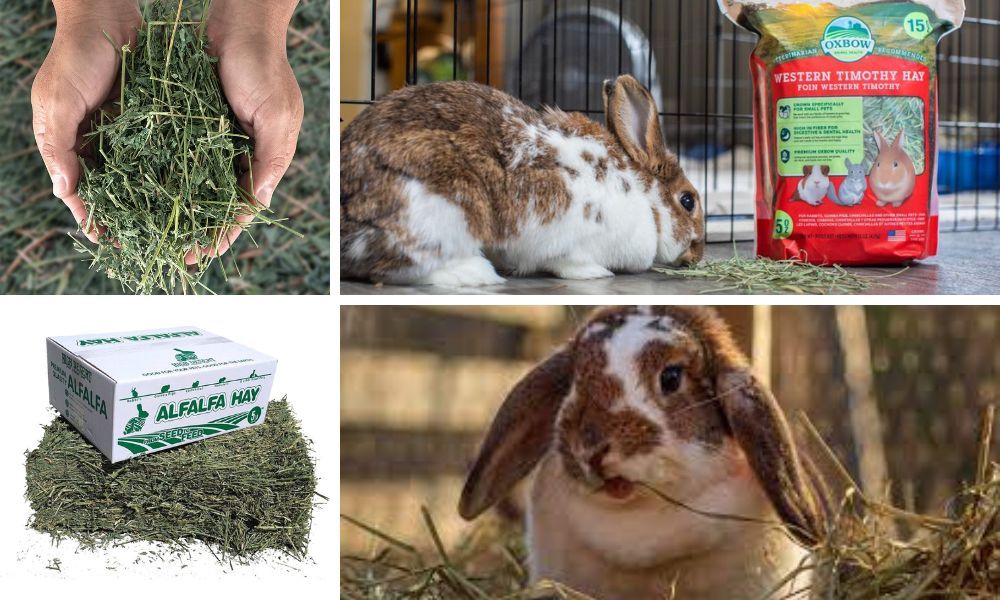
Cleaning and Maintenance
Keeping the litter box clean is essential for the health and well-being of your rabbit. Daily scooping and regular washing with mild, non-toxic cleaners can prevent the buildup of ammonia and keep the litter box inviting. Allowing vinegar to sit in the litter box for a minute during cleaning can effectively tackle odor and hygiene issues.
Health Monitoring Through Litter Box Habits
Changes in litter box habits can be an early indicator of health issues in rabbits. Regular monitoring of how much your rabbit is peeing and pooping can help catch potential health problems early. It is also important to continue using high-quality materials and ingredients to ensure the well-being of bunnies.
Litter Box Solutions for Multiple Rabbits
If you have multiple rabbits, having multiple boxes is crucial. Each rabbit should have access to at least one litter box, plus one extra in the enclosure to prevent territorial disputes. Additionally, ensure the litter box is designed for large bunnies to prevent territorial disputes and ensure comfort.
DIY Litter Box Options
For those who love DIY projects, creating a custom litter box tailored to your rabbit’s needs can be a rewarding endeavor. Using items like storage containers can be an economical and effective solution. You can find suitable containers and accessories for these DIY litter box projects in the ‘Small Animal’ or ‘Cat’ sections of pet stores, offering a variety of dimensions and unconventional options for customization. Searching for the right containers and accessories in these sections ensures you find options that cater to various types of bunnies, including aging and disabled ones.
Troubleshooting Common Issues
Even with the best setup, you may encounter some issues with your rabbit’s litter box habits. Understanding and addressing these problems promptly can help maintain a clean and healthy environment for your pet.
Rabbits may stop using their litter box for several reasons, including illness, old age, or changes in their environment. If a normally litter-trained rabbit starts urinating outside the box, it could indicate a urinary tract infection or other health problems. It’s important to consult a veterinarian if you notice any sudden changes in your rabbit’s litter box habits.
Older rabbits may have trouble jumping into a standard litter box due to arthritis or other mobility issues. In such cases, modifying the litter box can make a significant difference. Cutting one side of the box lower can help an older rabbit with arthritis access the litter box more easily. Alternatively, a puppy training box can provide a larger and more accessible option for older rabbits.
For older rabbits, a litter box with dimensions of 24L x 20W x 5H inches (60L x 50W x 13H cm) and a lower lip of 3 inches high (8 cm) can be a suitable option. This design allows easy access while still providing enough space for the rabbit to move around comfortably.
By understanding the common issues that can arise and making necessary adjustments, you can ensure that your rabbit continues to use their litter box effectively. Regular monitoring and prompt action can help maintain a clean and healthy environment for your rabbit, ensuring their well-being and happiness.
Common Mistakes to Avoid
Avoid using materials like clay or clumping cat litter, as these can be harmful if ingested by your rabbit. Also, placing the litter box in noisy or high-traffic areas can discourage your rabbit from using it. Note that it is important to consider the design of the litter box entry, such as the presence of a lip, which may not be suitable for all disabled bunnies.
Summary
Selecting the right litter box for your rabbit involves considering the size, type, and material of the box, as well as the type of litter that is safe for rabbits. Proper placement and diligent training are crucial for helping your rabbit adapt to their new litter box. Regular cleaning and health monitoring through litter box habits are essential for maintaining your rabbit's health and hygiene.
FAQ
Q1: How often should I clean my rabbit’s litter box?
A1: Scoop the litter box daily and perform a thorough cleaning at least once a week to maintain hygiene and comfort.
Q2: Can I use cat litter for my rabbit’s litter box?
A2: It is best to avoid cat litter, especially clumping types, as they can be harmful if ingested by rabbits. Opt for rabbit-safe options like paper pellets or wood pellets.
Q3: How do I train my rabbit to use the litter box?
A3: Place your rabbit in the litter box after meals and naps, and reward them with treats for using it. Consistency and patience are key in litter box training.
Q4: What makes the best litter box for rabbits?
A4: The best litter box for rabbits is one that combines ease of cleaning, durability, and thoughtful design. Customers often praise litter boxes that are easy to assemble, with parts that snap on and off effortlessly for quick cleaning. The ideal litter box should also feature solid construction and smooth plastic to withstand frequent use and make maintenance a breeze. These qualities not only ensure the litter box lasts longer but also enhance the overall experience for both rabbits and their owners, making it the best choice for rabbit care.
Q5: Why is selecting the right size of litter box important for rabbits?
A5: Selecting the right size of litter box is crucial to accommodate rabbits of all sizes, from small to large breeds. Proper sizing ensures ease of access, particularly for older or disabled rabbits, and is essential for effective litter box training and safety. A well-sized litter box provides comfort and helps prevent accidents, making it an important factor in maintaining your rabbit's hygiene and well-being.

